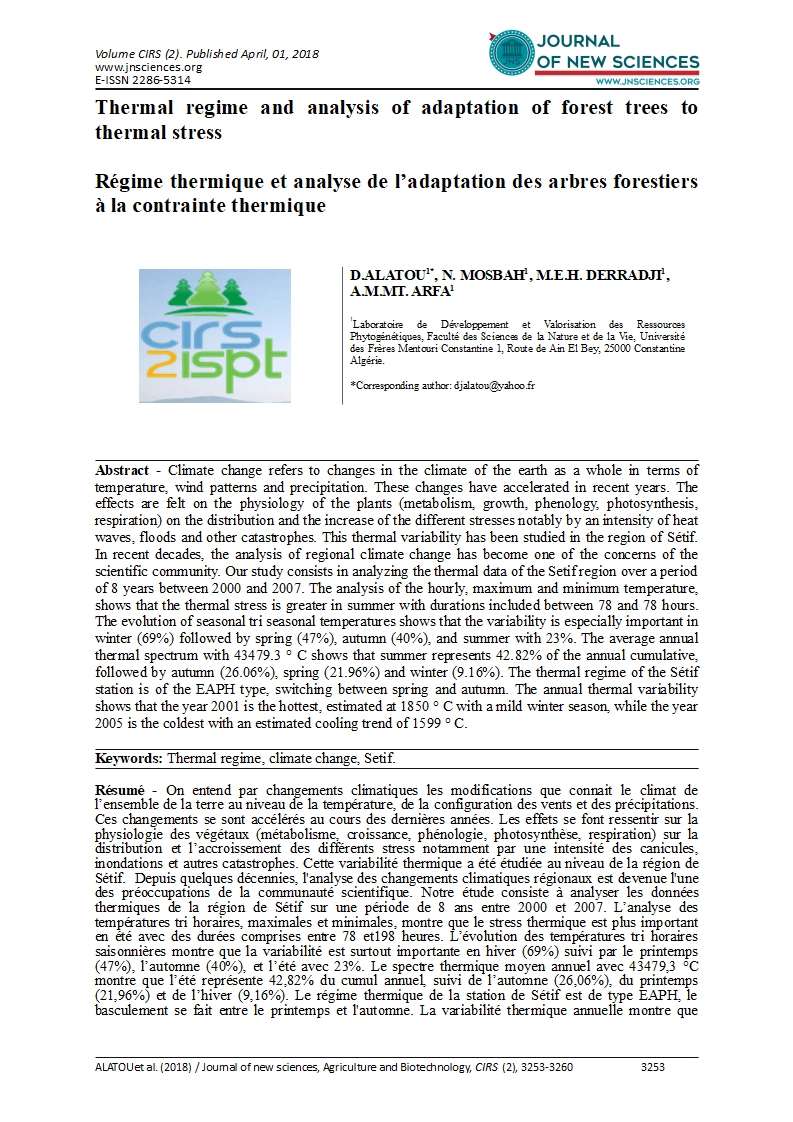

- Category: VOLUME SPÉCIAL (CONFÉRENCE CIRS 2017)
- Hits: 9810
Thermal regime and analysis of adaptation of forest trees to thermal stress
Régime thermique et analyse de l’adaptation des arbres forestiers à la contrainte thermique
|
|
D.ALATOU1* N. MOSBAH1 M.E.H. DERRADJI1 A.M.MT. ARFA1
1Laboratoire de Développement et Valorisation des Ressources Phytogénétiques, Faculté des Sciences de la Nature et de la Vie, Université des Frères Mentouri Constantine 1, Route de Ain El Bey, 25000 Constantine Algérie.
|
Abstract - Climate change refers to changes in the climate of the earth as a whole in terms of temperature, wind patterns and precipitation. These changes have accelerated in recent years. The effects are felt on the physiology of the plants (metabolism, growth, phenology, photosynthesis, respiration) on the distribution and the increase of the different stresses notably by an intensity of heat waves, floods and other catastrophes. This thermal variability has been studied in the region of Sétif. In recent decades, the analysis of regional climate change has become one of the concerns of the scientific community. Our study consists in analyzing the thermal data of the Setif region over a period of 8 years between 2000 and 2007. The analysis of the hourly, maximum and minimum temperature, shows that the thermal stress is greater in summer with durations included between 78 and 78 hours. The evolution of seasonal tri seasonal temperatures shows that the variability is especially important in winter (69%) followed by spring (47%), autumn (40%), and summer with 23%. The average annual thermal spectrum with 43479.3 ° C shows that summer represents 42.82% of the annual cumulative, followed by autumn (26.06%), spring (21.96%) and winter (9.16%). The thermal regime of the Sétif station is of the EAPH type, switching between spring and autumn. The annual thermal variability shows that the year 2001 is the hottest, estimated at 1850 ° C with a mild winter season, while the year 2005 is the coldest with an estimated cooling trend of 1599 ° C.
Keywords: Thermal regime, climate change, Setif.
Résumé - On entend par changements climatiques les modifications que connait le climat de l’ensemble de la terre au niveau de la température, de la configuration des vents et des précipitations. Ces changements se sont accélérés au cours des dernières années. Les effets se font ressentir sur la physiologie des végétaux (métabolisme, croissance, phénologie, photosynthèse, respiration) sur la distribution et l’accroissement des différents stress notamment par une intensité des canicules, inondations et autres catastrophes. Cette variabilité thermique a été étudiée au niveau de la région de Sétif. Depuis quelques décennies, l'analyse des changements climatiques régionaux est devenue l'une des préoccupations de la communauté scientifique. Notre étude consiste à analyser les données thermiques de la région de Sétif sur une période de 8 ans entre 2000 et 2007. L’analyse des températures tri horaires, maximales et minimales, montre que le stress thermique est plus important en été avec des durées comprises entre 78 et198 heures. L’évolution des températures tri horaires saisonnières montre que la variabilité est surtout importante en hiver (69%) suivi par le printemps (47%), l’automne (40%), et l’été avec 23%. Le spectre thermique moyen annuel avec 43479,3 °C montre que l’été représente 42,82% du cumul annuel, suivi de l’automne (26,06%), du printemps (21,96%) et de l’hiver (9,16%). Le régime thermique de la station de Sétif est de type EAPH, le basculement se fait entre le printemps et l'automne. La variabilité thermique annuelle montre que l'année 2001est la plus chaude, estimée à 1850°C avec une saison hivernale douce, alors que l'année 2005 est la plus froide avec une tendance de refroidissement estimée à 1599 °C.
Mots clés :Régime thermique, changement climatique, Sétif.

